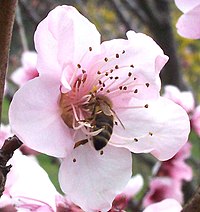
Photo from wikipedia
Simple Summary Bees and other pollinators play a vital role in food production and natural ecosystems. Native bee populations are declining due in part to habitat loss. Individuals can help… Click to show full abstract
Simple Summary Bees and other pollinators play a vital role in food production and natural ecosystems. Native bee populations are declining due in part to habitat loss. Individuals can help bees by landscaping with plants that provide pollen and nectar. Most information on bee-friendly plants concerns herbaceous ornamentals, but flowering trees and shrubs, too, can provide food for urban bees. Conservation organizations recommend landscaping mainly with native plants to support native bees, but some studies suggest that including some non-invasive non-native plants that bloom earlier or later than native plants can help support bees when resources from native plants are scarce. That strategy might backfire, however, if such plants disproportionately host invasive bee species. This study tested that hypothesis by identifying all non-native bees among 11,275 bees previously collected from 45 species of flowering woody plants across hundreds of urban sites. Besides the ubiquitous honey bee, six other non-native bee species comprised 2.9% of the total collection. Two alien species considered to have invasive tendencies by outcompeting native bees were more abundant on non-native plants. Planting their favored hosts might facilitate those bees’ spread in urban areas. Pros and cons of non-native woody landscape plants for urban bee conservation warrant further study. Abstract Urban ecosystems can support diverse communities of wild native bees. Because bloom times are conserved by geographic origin, incorporating some non-invasive non-native plants in urban landscapes can extend the flowering season and help support bees and other pollinators during periods when floral resources from native plants are limiting. A caveat, though, is the possibility that non-native plants might disproportionately host non-native, potentially invasive bee species. We tested that hypothesis by identifying all non-native bees among 11,275 total bees previously collected from 45 species of flowering woody landscape plants across 213 urban sites. Honey bees, Apis mellifera L., accounted for 22% of the total bees and 88.6% of the non-native bees in the collections. Six other non-native bee species, accounting for 2.86% of the total, were found on 16 non-native and 11 native woody plant species. Non-Apis non-native bees in total, and Osmia taurus Smith and Megachile sculpturalis (Smith), the two most abundant species, were significantly more abundant on non-native versus native plants. Planting of favored non-native hosts could potentially facilitate establishment and spread of non-Apis non-native bees in urban areas. Our host records may be useful for tracking those bees’ distribution in their introduced geographical ranges.
Journal Title: Insects
Year Published: 2022
Link to full text (if available)
Share on Social Media: Sign Up to like & get
recommendations!